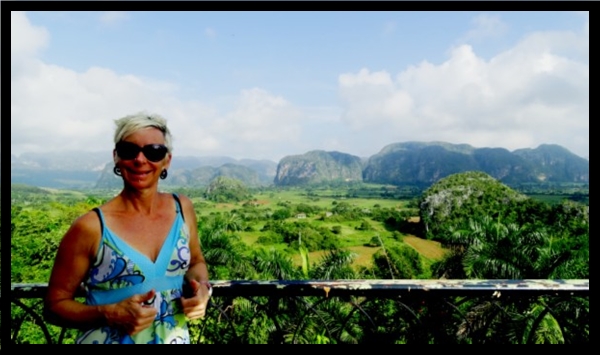
gorgeous Vinales
I’m 50/50 on Cuba…
I just spent one full month exploring the intriguing island-nation of Cuba. I visited all the main tourist destinations, including Havana, Vinales, Trinidad, Cienfuegos and a couple tropical beaches near those latter cities.
I traveled at a leisurely pace, staying considerably longer in each destination than most visitors, who generally spend just 1-2 weeks in the country.
Cuba is certainly a very interesting and educational place to visit. It has many great things to see, do and learn about, from the thousands of iconic colorful vintage cars to the crumbling historic buildings and cities to the wonderfully hospitable & kind guest house owners to the gorgeous limestone karst mountains of Vinales and the pristine, powdery-sand beaches lining the entire island.
Unfortunately, there are equally as many hassles, annoyances and down-sides to life & travels in Cuba as there are wonderful things. Annoyances like constant pestering and lying by touts, severe over-pricing of nearly everything for visitors, expensive money exchange, blaring Reggaeton music, almost complete lack of fresh produce, little meal variety, under-equipped toilets and almost universally terrible customer service.

Havana panorama from El Moro Fortres
Overall, for me anyhow, the annoyances and negatives slightly outweighed the positives.
Truth be told, I had had enough of Cuba after 18 days! I felt I’d ‘got’ what Cuba is like, had my fill and was ready to be on my way.
I’m quite sure that if I’d been in any other country, with good internet access and the ability to use my debit card and/or online banking, that I would have changed my flight and left 10 days earlier than planned.
Unfortunately for me, as an American, I had NO access to money while in Cuba – could not use my ATM / Debit cards nor do any online banking. So I could not change my flight. Instead, I just grinned and bared it for another 11 days until my pre-scheduled flight day finally arrived.
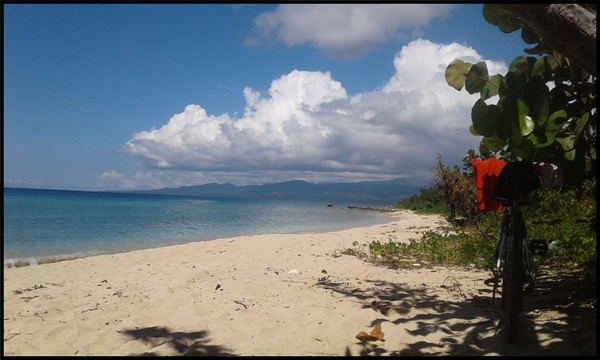
PLaya Ancon near Trinidad
Of course I found plenty to do during my 11 days in ‘limbo’. I cycled to a beautiful beach, enjoyed sunsets and mojitos up on my private rooftop while listening to live Cuban music, photographed Havana more seriously, visited my many cat friends, discussed Cuban daily life/history and politics in depth with my guest house hosts and enjoyed a free walking tour of Havana that I had previously missed.
So I quite easily managed to enjoy my remaining 11 days in Cuba. But I was also counting down to my departure day, eager to be gone.
In retrospect, I think two weeks is probably a better time-frame for visiting Cuba. Travelers exploring the island with just two weeks would have enough time to visit the best destinations, enjoy the greatest attractions & activities without having so much time that they’d get sick of the bland, unvaried food or become too aggravated by the constant sales pitches, lying, cheating and over-pricing.
‘Get a quick taste and get out’ is my recommendation for visiting Cuba.
Following are what I consider to be the great and not-so-great aspects of visiting Cuba. As you’ll see from the lists, they’re pretty evenly divided.
Of course, this is all completely subjective. It’s quite likely that some things I really enjoyed about Cuba are things other people might not care about at all. And things that annoyed me supremely won’t bother some travelers in the least.
In any event, here’s what any traveler to Cuba is likely to come across while exploring the island. Judge for yourself whether these things will add a positive, negative or neutral angle to your trip.
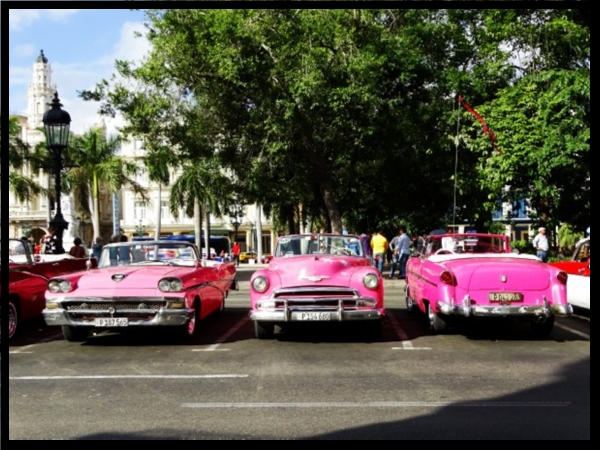
beautiful vintage cars are all over Havana
Great things about Cuba
Cuba’s iconic, colorful vintage cars
Honestly, the ongoing rainbow kaleidoscope of Cuba’s gorgeous vintage cars is the #1 best thing about the country in my opinion. Nowhere else on the planet can you see thousands of beefy classic 1950s cars freely driving around the streets. They make Cuba truly unique.
Kind, warm, hospitable guest house hosts
Most travelers to Cuba will be staying in ‘casa particulares’ – rooms inside a family home. Nowadays thousands of Cuban couples & families rent out 1-2 rooms to the ever-flowing stream of tourists. These hosts are warm, kind, helpful and very hospitable. They make a visit to Cuba really special & personal.
Random acts of kindness & generosity from Cubans in public
In the midst of nearly constant sales pitches, scams, lies and pushy touts, out of nowhere appear Cubans who are the complete antithesis. They’re like brightening stars or little angels.
On several occasions I had bus passengers (who I know are dirt poor) offer to pay my fare since I didn’t have small change. I also had shop vendors just hand me the fruits I was looking for since they didn’t know the prices or only had a couple small pieces remaining.
Cuba is safe
While traveling in Cuba, you don’t have to worry about your safety. There’s not really any violence against tourists. And that makes traveling there relaxing and comfortable.
Aside from the occasional petty theft of personal items, usually from tourists doing dim-witted things like leave their wallet out in a bar while drinking, you don’t have to worry about your possessions either.
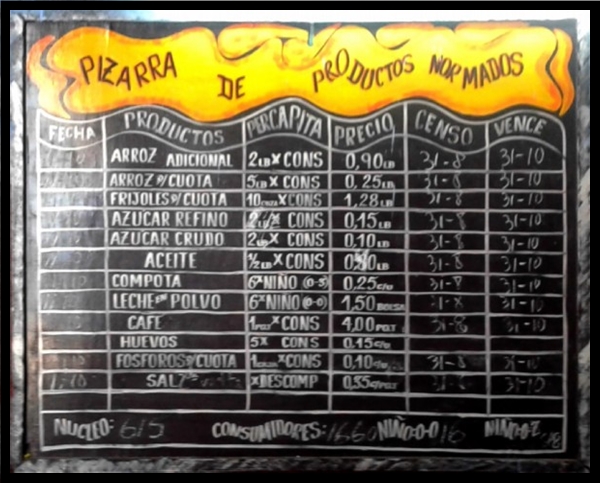
state shop prices for goods
Buying some of the world’s least expensive foods & daily needs
I always get a small thrill out of buying things at super low prices. In Cuba I drank shots of Cuban coffee for 1 peso / 5 cents US, found Cuban chocolate bars for 5 pesos/20 cents US, ate huge plates of spaghetti with cheese for 25 pesos/$1 US, enjoyed personal-size pizzas for 12 pesos/50 cents US.
I rode the ferry across Havana channel for 0.20 peso/ 1 cent US, a modern bus across the city for 0.40 peso/2 cents US and took a 45-minute ferry ride through gorgeous Cienfuegos Bay for 0.50 Cuban dollar/0.50 US.
Experiencing a very different type of daily living
Shops run out of products on a regular basis, so you never know if you’ll be able to buy what you set out for. What is available offers little variety. Cities are noisy, but in an entirely different way- there’s little traffic or electronic noise, but there’s a lot of noisy people yelling and playing the streets. Nearly everything is of poor quality.
Share taxis
In Havana, fleets of ‘taxi collectivos’ run regular routes through the city while picking up and dropping off passengers, all sharing the same taxi together. They include modern yellow taxis, older modern-ish cars and even hundreds of gorgeous vintage cars.
The fare is always just 10 pesos / 0.40 cents US
I took share taxis around Havana several times. Sometimes I lucked out riding a vintage car.
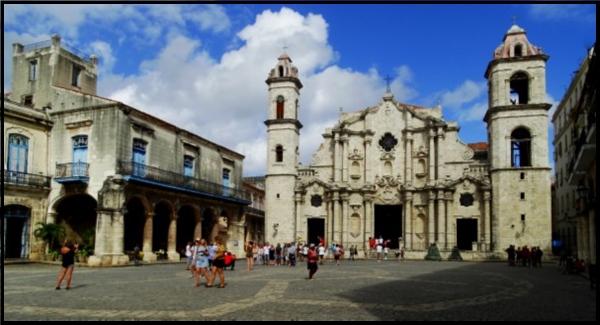
Plaza Catedral – Havana
Historic architecture – some well-preserved, most crumbling
Cuba is full of historic architecture, mostly built by the Spanish from the 1500s to the 1800s. Havana is particularly jam-packed with thousands of 3-4-story colonial buildings. Hundreds of blocks of them.
A small percentage of key buildings are well-preserved and sparkling in grandeur. But most are in some state of disrepair and decay. Most of Havana looks like a giant ghetto.
Being a huge fan of architecture, I found Cuba’s historic buildings one of the best things about the country. And their decaying state makes Cuba quite different from neighboring countries like Mexico; Antiqua, Guatemala and Granada, Nicaragua.
Traditional Cuban music – when you can find it
I love traditional Cuban music and I was really looking forward to hearing it. I imagined I’d hear it all over the place, all day and night, out in the streets and plazas, restaurants and cafes.
Quite unfortunately, Raggaeton hit Cuba about two years ago. Now that’s the music I heard almost everywhere in Cuba. I HATE Reggaeton, so it really ruined my visit!
Fortunately, I DID also get to hear Cuba’s wonderful traditional music. On occasion. Usually only in evenings at popular tourist destinations like Plaza Vieja, Havana.
Trinidad was the only place where I heard live Cuban music everywhere, like I’d imagined. I even lucked out with my guest house, which was situated right beside a restaurant with a daily live band playing all afternoon & evening. That really made my visit to Trinidad!
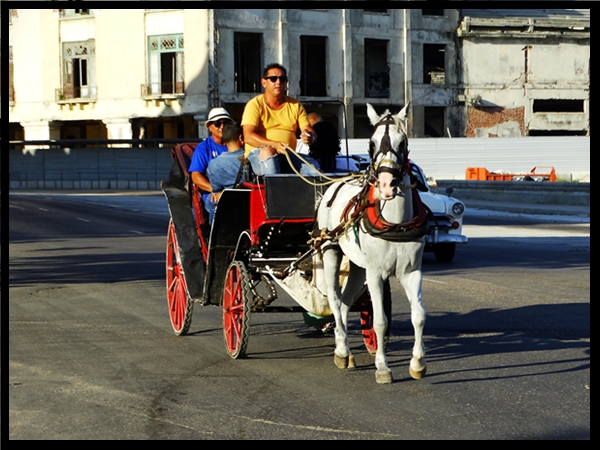
horse n carriage – Havana
Horses
There are many working horses in Cuba. In cities, horse & carriages take travelers on tours. Horse & carts haul construction & farm goods. Farmers and other country folk ride horses instead of cars.
Potable drinking water
Despite what you may hear or read, the tap water all over Cuba is potable! I drank it exclusively during my entire month in the country. And I never once got sick or had any belly ailments.
Having potable water not only reduces expenses greatly, but it also means all fruits & vegetables are safe to eat without worry about getting a stomach ache.
Freshly squeezed fruit juices
One of the few really delicious food items in Cuba are the thick, freshly-squeezed fruit juices. During my visit in October, mango, orange and guava were the main fruit juices available. I had a glass or two every day that I was in the country at my various guest houses. Delicious and healthy.
Cuban coffee serving for 1 peso / aka 5 cents US
I drank strong Cuban coffee at my various guest houses every day. But I also got a kick out of buying tiny espresso-cup-size coffees at local stalls for just 1 peso/ 5 cents US. I usually drank 2-5 cups. But heck, 5 cups cost me just 25 cents US! It must be the cheapest coffee in the whole world.
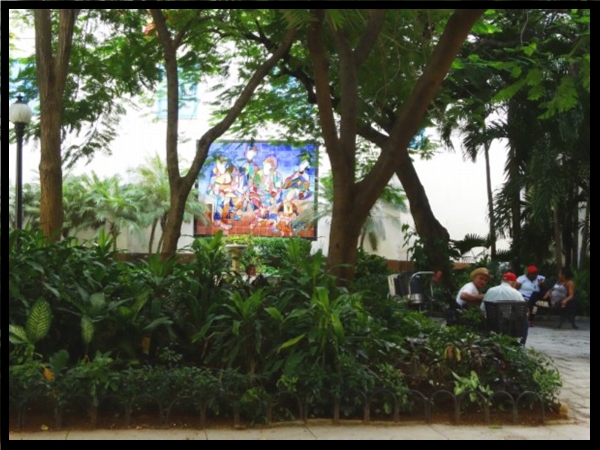
Art in park – Havana
Art & galleries & museums
I discovered that Cuba has a long history of great artists, particularly painters. Most of them create very colorful artworks.
While in Cuba I visited many small art galleries and some key art museums, where I got to admire decades of Cuban art. There’s also a lot of colorful street art.
Little traffic = uncrowded roads, little traffic noise or pollution
Not many Cubans own cars, or motorcycles for that matter. That leaves the streets fairly empty of traffic, even on most roads in Havana. As a result, there’s relatively little traffic noise and it’s extremely easy to cross the street.
Overland travel is also much easier with practically empty roads all over the country.
Little TV, cell phone or other electronic noise
Likewise, very few people have modern electronics, though that is certainly changing rather quickly these days. For the time being, there’s little noise from TVs, cell phones, radios or other gadgets. I quite enjoyed the break from typical modern-day noise.
Lots of cats
As everyone probably knows by now, I’m enamored of cats. Whenever I come across a cat anywhere, I feel compelled to say hello and try to befriend them.
In Cuba I plenty of chances to pet and be-friend cats. I had special cat friends to visit in every city I went to. And I ended up rescuing a few cats & kittens along the way, too. So cats really enhanced my travels around Cuba.
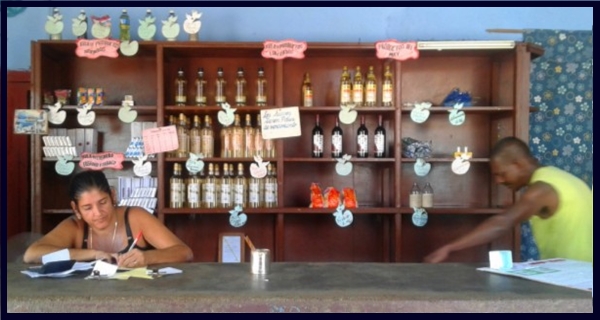
state shop in Trinidad
Downsides of travel in Cuba
Reggaeton music
The Latin world has been swept by the storm of Reggaeton music, apparently for several years now. I absolutely hate it. In fact, it’s such a turn off to me that I’ve given up on exploring any more Latin countries for the time being. I can’t bear it any more! I can only hope the wave will die out some year soon.
It never crossed my mind that I’d hear Reggaeton in Cuba! After all, Cuba has absolutely amazing traditional music. To my horror, Reggaeton has hit Cuba as well.
In fact Reggaeton is the primary music I heard all the time in Cuba, all over the country. It’s played on cell phones, in taxis, on tricycles, in shops and restaurants. Everywhere.
That was one of the worst things about my visit to Cuba. It also meant that…
Cuban traditional music is no longer so easy to encounter!
Don’t get me wrong, traditional Cuban music is played regularly in popular tourist spots – plazas, restaurants, bars – during evenings. And there are clubs specializing in Salsa, Rumba and other traditional Cuban music. But you have to go search it out.
I was expecting to hear Cuban music everywhere, all day long, all the time. That’s what I was told by travel guides and bloggers. But that’s not what I experienced. Seems it’s been replaced by that dreaded Reggaton. Ugh.
I did hear lots of traditional, live Cuban music in Trinidad, however. And that was wonderful. But outside of Trinidad, it was rare I heard much besides that crappy take over.
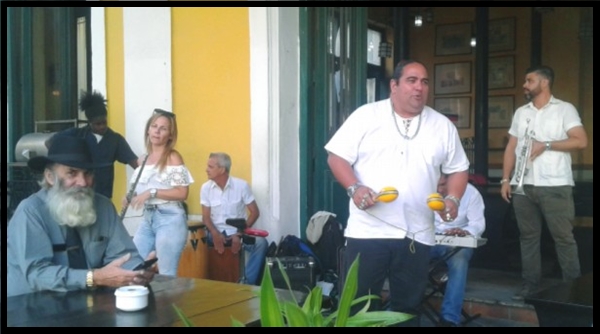
Cuban band in Plaza Vieja – Havana
Half the Cuban population who are unfriendly, apathetic, unhelpful
As I noted above, Cuba’s many guest house hosts are really warm, kind and hospitable. But as soon as you step out the door, it’s an entirely different story.
People out on the streets look serious, stone-faced, disheartened. They do not greet people as they pass by, like in Mexico and C American countries. They are slow to smile, slower to laugh. They just do not seem happy.
Shop, museum, market, restaurant and bar staff are generally lethargic, inattentive, apathetic. They seem particularly unhappy. There’s no pride in work, no sense of good customer service. And who can blame them, knowing they make just $20 US a month in salary?! That’s less than $1 US per day!
And while I can understand it and certainly empathize with them, it definitely does not make for a pleasant, enjoyable time walking the streets or going to buy anything.
As a result…
Cuban cities do not have a happy vibe
A large group of Cubans lie, cheat, scam and pester visitors
Besides the grim, apathetic Cubans, there’s a huge body of more aggressive residents. They outright lie, deceive, over-charge or otherwise try to take advantage of visitors to Cuba.
Again, I can understand that they’re desperate to make enough money to live. However, they make being a visitor to Cuba quite aggravating and disheartening. I found it really annoying to be constantly lied to and feel I had to be on my guard against getting ripped off.
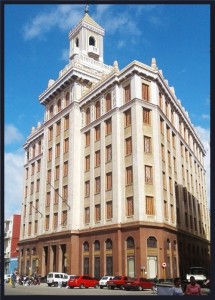
Bacardi building
Noisy streets due to people yelling
Although there’s relatively little traffic or electronic noise in Cuban cities, they’re still noisy. People are constantly out in the streets, talking loudly, yelling and playing ball games.
Expensive money exchange
The only place visitors can get Cuban currency is inside Cuba. The government levies and automatic 3% fee. US dollars additionally are charged 10%, meaning visitors with $US are charged 13%. That’s pretty hefty. Even the 3% adds up. And it’s considerably more than what I’m used to paying to exchange money anywhere else in the world.
I took Mexican pesos with me, so was charged ‘just’ 3%. However, to my bad fortune, the Mexican peso increased in value while I was in Cuba. So I ended up losing 7% from the rate I had withdrawing Mexican pesos from the ATM in Mexico City.
Over one month, I ended up wasting over $50 US just exchanging my money! And that did not enamor me to visiting Cuba.
Severe over-pricing for visitors
In Cuba there are all sorts of ways in which visitors are severely over-charged. Museum entry fees, club and show entry fees, costs of meals, bus prices, tour prices, overland travel and cheating by touts are primary examples.
And I’m not talking double or even triple price hikes compared to prices for Cubans. I’m talking 20-25 times more expensive! And that’s a bit extreme in my opinion.
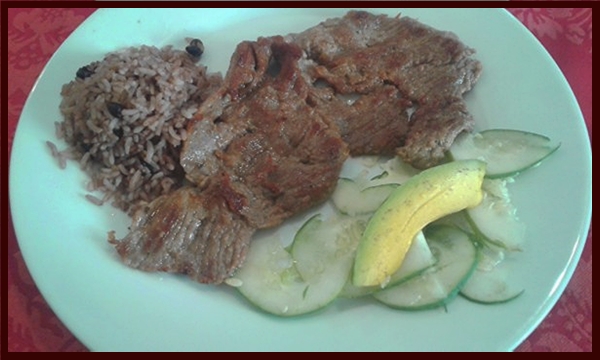
typical Cuban meal – beans & rice, pork and salad
Rice mixed with beans – aka ‘Christian & Moros’ in Cuba
My second biggest pet peeve about Latin American countries – after Reggaeton – is their mixed beans and rice dish. In Central America it’s called ‘gallo pinto’. It’s awful.
I thought I was done with gallo pinto for good, so I was horrified to discover it’s the main dish in Cuba as well! Ay yai yai! Cubans call it ‘Christian & Moros’ for it’s white and black color scheme. It made eating in Cuba all the more awful for me.
Crappy food with little variety
The standard meal in Cuba is either chicken or pork with mixed rice & beans and a tiny smidget of ‘salad’. That consists of a few paper-thin slices of cucumber, perhaps a bit of cabbage or lettuce or tomato. That’s about it for Cuban meals.
To be fair, the chicken and pork are cooked in different ways. And fish & shrimp are served in many places, at higher prices. Small street stalls also sell pizzas and pork or ham & cheese sandwiches. So there’s a bit of variety, but not much.
Markets sell a very limited selection of fruit & vegetables. Bakeries have one or two items. Canned & packaged foods are extremely limited. Basically, it’s the same few foods day in and day out.
Most food lacks any flavor – most fruits, veggies, desserts
I was surprised at the lack of flavor in most fruits and vegetables in Cuba. I’ve never eaten bananas or bell peppers that was so bland, for instance.
Likewise, all the desserts I ate from various cake shops basically had zero flavor. They have lots of texture, but no flavor. Cuba’s famous ice-cream, Coppellia, is also the blandest ice-cream I’ve ever eaten in my life.
Poor quality coffee
Cuban coffee is brewed strong and thick like espresso, just the way I like it. But it’s not really the best tasting coffee in the world. I have had Cuban coffee outside of Cuba several times that had much better flavor, which leads me to guess that the coffee available inside the country is of lower quality than what’s exported.
During my visit to Cuba I was certainly happy to have strong coffee available every day, and at very cheap prices. But by the time I left I couldn’t wait to start drinking better coffee.
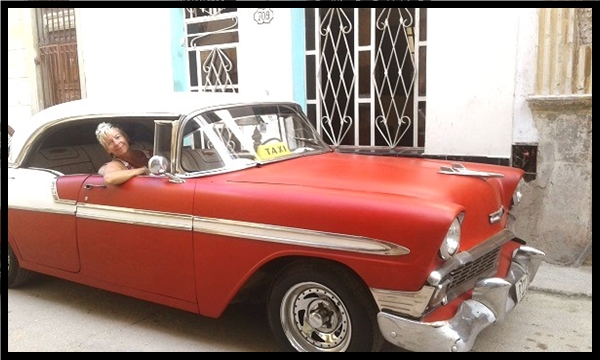
heading to the airport in Havana in a spiffy 1950s car!
Expensive overland transportation
Expensive is a relative term. So visitors arriving from Europe or North America might consider Cuba’s overland bus and share-taxi rates reasonable or even cheap.
However, budget travelers like me, accustomed to super cheap public busses will definitely find Cuba overland transportation expensive.
I spent about $120 US in transportation in one month, just by visiting three destinations outside Havana. That’s really steep for budget travel and compared to countries of Central America or SE Asia. I generally spend about $20-50 US per month on overland travel.
Visitors to Cuba actually can also take the normal, overland buses that Cubans take. But…
Local buses – extremely crowded, infrequent
Those buses are generally extremely crowded (think sardines), run infrequently and are very time consuming. I was also told by my guest house host that passengers’ luggage and personal possessions could be liable to theft.
I did talk with a few super budget travelers who used those local overland buses. They all said it chewed up a lot of time and was a lot of hassle.
I didn’t bother trying them since I’m not at all keen on sardine-can-cramped buses. No thanks.
The climate is broiling hot
In October in Havana, I found it almost too hot to sleep. And that’s pretty rare for me. I had to use a fan blasting directly over my body. Daytime temperatures are often so hot that it’s hard to do anything at all.
I did luck out with many cloudy days and a bit of rain during my month in Cuba. Those days were cooler – cool enough to do things even in the middle of the day. I’d hate to visit Cuba in July, Augsut or September, based on my October experiences!
Apparently Cuba is cooler during its high tourist season, December through March. For anyone not enamored of heat, that would be a better time to visit.
Long lines to buy anything, use banks, etc
Summary
Cuba is a very interesting, unique destination. There are things in Cuba you literally will not find anywhere else in the world, such as the thousands of colorful vintage cars and 5 cent cups of coffee.
But there are also many hassles and downsides to traveling around Cuba.
It’s definitely worth visiting Cuba, but I’d suggest limiting the trip to two weeks. That’s enough time to get the feel of the country, see and do the best things on offer, but not get too irritated by all the hassles.
==========================================================================












 Hi! I'm Lash, an American nomadic world traveler who's been traveling solo since 1998. I’m passionate about traveling the world nomadically and then sharing it all with you. I hope to inspire you to travel the world, to entertain you with tales from the road, and to help you reach your travel dreams. Welcome!
Hi! I'm Lash, an American nomadic world traveler who's been traveling solo since 1998. I’m passionate about traveling the world nomadically and then sharing it all with you. I hope to inspire you to travel the world, to entertain you with tales from the road, and to help you reach your travel dreams. Welcome! 



